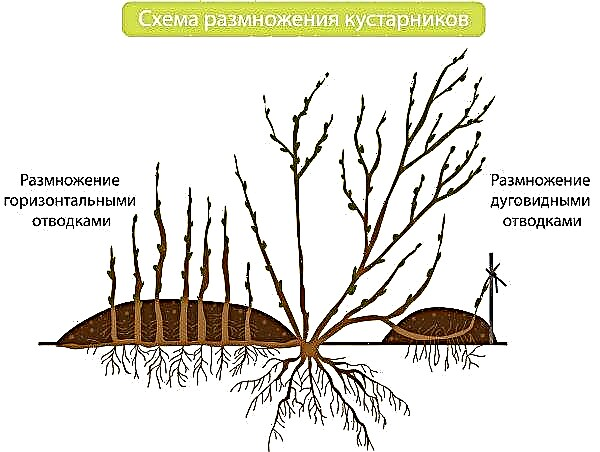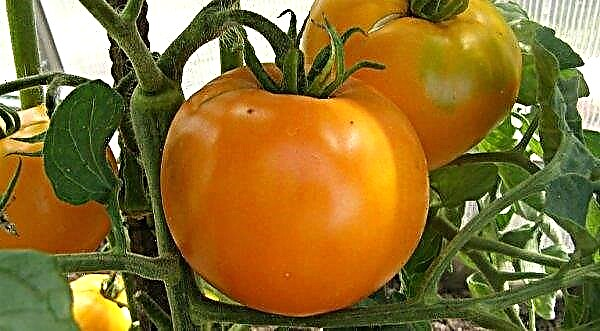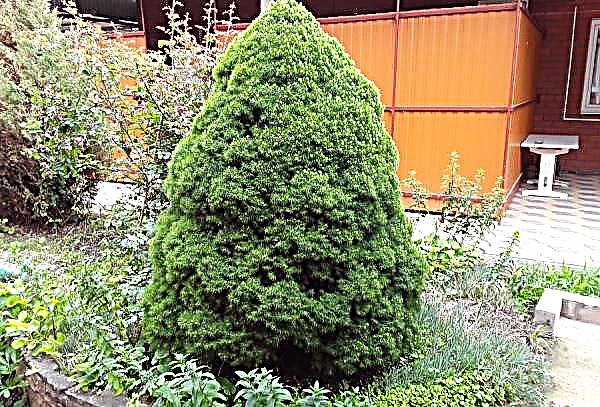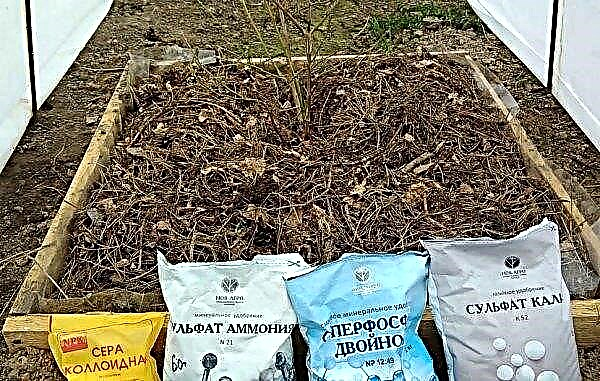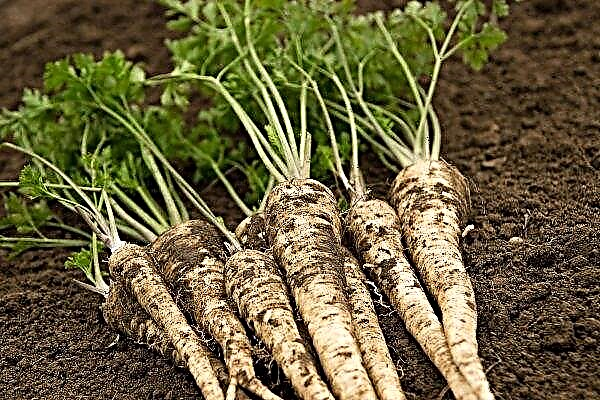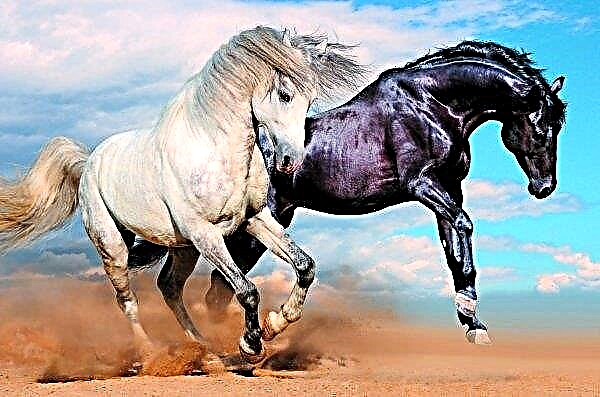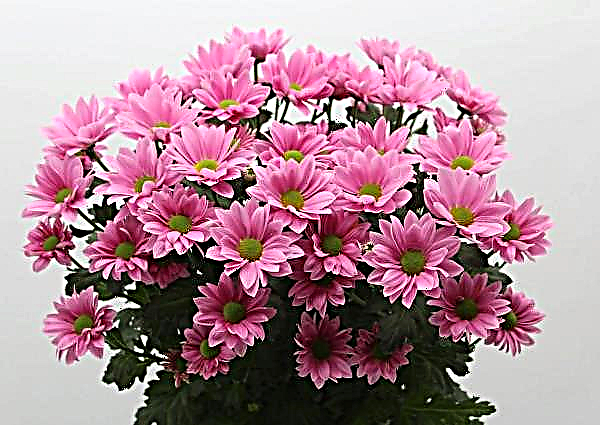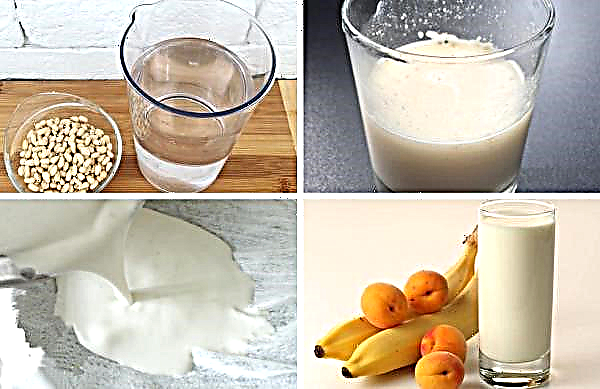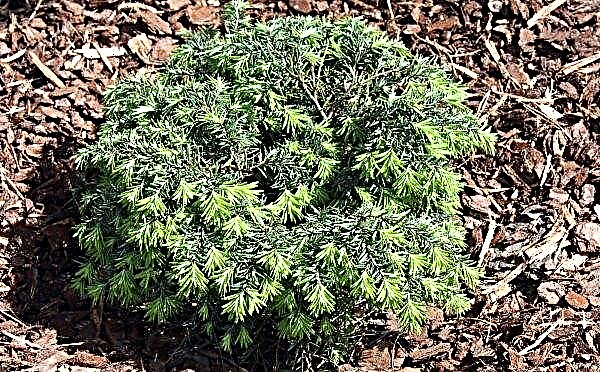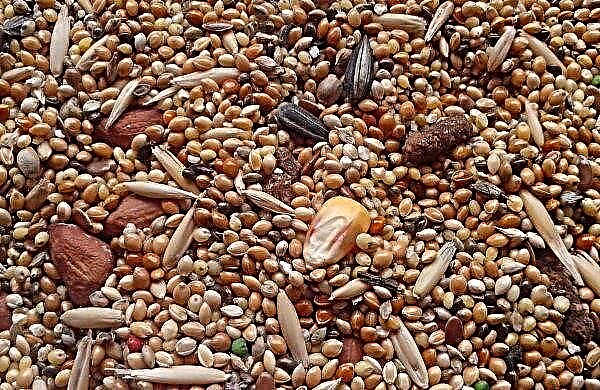An increasing number of homeowners are trying to grow conifers on their site, especially since today you can buy these evergreen plants in specialized nurseries in a huge assortment and for every taste. A real decoration of the local area can be slender, unusual in our latitudes, but at the same time quite frost-resistant thuja, for example, such a variety as Malonyana. A detailed description of this bright and beautiful tree, its varieties, as well as the features of growing are described below in the review.
Botanical Description
Maloniana - a variety of western arborvitae, which, in turn, is the most common decorative conifer, loved by landscape designers and simple gardeners due to its good survival rate in a temperate climate zone.
The historical homeland of the tree is the USA and Canada, that is, the states of the Western Hemisphere, hence its generic name and the main difference from the ploskadochnik, or the Oriental thuja, distributed mainly in China and Korea.Did you know? In the wild, the western thuja can live up to a thousand years, but for the Cypress family, to which this tree belongs, this is not the limit. So, for example, in Iran grows cypress called Sarv-e-Abarku, whose estimated age is 4000 years.

Giving a general description of Maloniana, the following botanical features of this conifer should be distinguished:
| Tree dimensions and crown shape | Height - up to 15 m, width - up to 0.6 m. The crown is compact, pyramidal with a point up. |
| Wood structure and color | Durable, but rather soft, dirty red in color, resin inclusions are absent, rarely rots. |
| Bark | In the first years of life, the tree is smooth, then gradually crackes in the vertical direction. Color - from reddish brown to brownish gray. |
| Needles | Shiny at the top and matte at the bottom, very fragrant, scaly, short. Clings to the branch tightly, changes every 2-3 years. In summer, green and blue, in winter it can become brown. |
| Bumps | Deprived of decorativeness. Small, finely scaled, gray-brown. |
| Seeds | Flattened, two in each bump. The wings are bright yellow. |
| Root system | Shallow (80–100 cm), widely branched. |
| Growth rate | Low, maximum annual growth of 30 cm. |
Varieties of thuja
For decorative purposes, several varieties of Malonian are grown, differing from each other in the size of the tree, the color of the needles and some other characteristics. The most common varieties of this thuja are Aurea and Holub.
Aurea
Aurea, the full Latin name for Thuja orientalis Aurea Nana, is an evergreen tree with a pointed top and a dense wavy crown of a pyramidal shape. The size of an adult plant is approximately 10 m in height and 2-3 m in width. The shoots are short, strong, multidirectional, branching at the ends like a fan, which gives the tree additional splendor. The needles are bright golden green with a beautiful sheen. In the absence of bright lighting it seems orange.
 Aurea looks equally decorative in the sunny area and in partial shade, but in the first case it requires more intensive watering. Winter hardiness is good, wood does not freeze even at -40 ° C.
Aurea looks equally decorative in the sunny area and in partial shade, but in the first case it requires more intensive watering. Winter hardiness is good, wood does not freeze even at -40 ° C.
Holub
Owners of small plots, it may make sense to pay closer attention to another species of Maloniana - Holub (Thuja occidentalis Malonyana Holub). It is a dwarf evergreen shrub with an asymmetric crown, consisting of several tops of different lengths, and short, randomly located, tightly adjacent to the trunk and slightly twisted to the sides with branches that give the plant a resemblance to an exotic coral. The needles are juicy green, short, but very dense.
The holub never grows more than 60–80 cm high and 70 cm wide, therefore it can be grown both in open ground and in containers. Moreover, the variety is characterized by very high winter hardiness - the conifer easily withstands frosts down to -33 ... -35 ° С. The only drawback during wintering is the yellowing needles, which, by the spring, nevertheless, are quickly restored.Did you know? The etymology of the word "thuja" (thuja) is not fully known: according to one version, it came from the ancient Greek language, and according to another, from Roman. Some historians believe that the name of the tree is associated with the concept of sacrificial incense, since it was its aromatic wood that our ancestors often used for burning during various religious rituals.

For the normal development of the holub requires good hydration, a high level of groundwater and mild swamping shrubs easier than drought. It grows well in a sunny area, although shading is also acceptable.
Landscape design application
All varieties of the western thuja Maloniana are very widely used in landscape design of regions with a temperate and even rather cool climate. Being very similar to thermophilic cypresses, but at the same time possessing very high endurance to cold and frost, they are able to create a corner resembling a resort area on a site located very far from the tropics. But in the south of Malonian grows very well, so there are no restrictions for its landing in warm regions either.
Did you know? Volatile substances, which are part of all conifers, contain natural volatile, killing pathogenic microflora in the atmosphere. In addition, these plants secrete the so-called aero ions (negative oxygen ions), which have the ability to activate red blood cells in the blood and improve oxygen metabolism in the body.
You can decorate a site with this evergreen tree in different ways, depending on the general style of the conceived composition and the selected plant variety. However, both Aurea and Holub look great both in group landing and as a solitaire. However, if Holub often plays the role of a central plant in a group, for example, when creating an alpine hill, then a tall Aureu is more logical to place in the background of the landscape composition.

Also, this type of thuja can be used to form hedges, including combining it with other conifers (the so-called mixboards). To mark a small path on a site or a whole alley in a park zone by lined bushes of Holub is another technique often used by landscape designers. Such a decoration can be made both one-sided and two-sided.
Landing
Like any trees, shrubs and other perennial plants, it is recommended to plant thuja either in spring or in autumn. But if a seedling with a closed root system is used, the procedure can be carried out even in the middle of summer. The main secret of success is the right choice of place, quality planting material and adherence to technology in the process.
Seedling Selection
Maloniana will take root better if you are guided by the following considerations when choosing a seedling:
- place of purchase - a specialized nursery, preferably located in the same area where the tree will be grown;
- tree age - from 3 to 4 years;
- the form of sale is in a container (with a closed root system), which allows planting by transshipment and, in addition, provides the plant with the necessary sustained-action nutrients, which should be enough for the first years of its life.

Site preparation
Maloniana shows a rather high resistance to adverse environmental factors (city dust, gas pollution, industrial emissions, smoke, etc.), on the contrary, it has the ability to clean the air. A positive side in the cultivation of arborvitae is also that it can be planted both in the sunny area and in partial shade, moreover, the latter option is considered more preferable, since the needles will not burn out in this case, and the root system will dry out. But the plant needs to be protected from strong winds, since this factor helps to reduce humidity and air, and soil, and thuja, especially young, does not have high drought tolerance.
As for the soil, the unpretentious as a whole Maloniana grows best when the soil meets these characteristics:
- reaction - slightly acidic or neutral (pH level in the range of 5.2–7);
- structure - light and moist (a great option is loam, on alumina Maloniana can grow with good drainage);
- humus content - high;
- groundwater flow - preferably high, but this parameter can be corrected by regular watering);
- fertility - a desirable, but not critical condition (thuja can grow on depleted soils, but to increase decorativeness and speed of development, it is better to make compost or humus in them before planting);
- nitrogen content - high;
- calcium content - high (on calcareous soils it can develop quite well);
- content of other salts - low.

Step-by-step instruction
Transplantation of the acquired Maloniana sapling to a permanent place involves the following algorithm of actions:
- Pit preparation. On depleted or inadequate soil for coniferous tree cultivation, the size of the pit should be at least twice the volume of the root system of the seedling (earthen coma, if the thuja is sold in a container).
- Bookmark the bottom of the pit of the drainage layer (sand, broken brick, gravel, expanded clay, etc.).
- Preparation of the soil mixture. As a basis, you can take the top layer of the earth, extracted from the pit. Depending on its initial state, peat, sand, humus or compost, as well as complex mineral fertilizer, for example, nitroammophoska (50-60 g), should be added to such soil. Part of the prepared mixture is laid out on the bottom of the pit, on top of the drainage layer, the rest will be used for subsequent sealing of voids.
- Transshipment The sapling should be taken with care, slightly supporting with one hand, removed from the container and installed in the pit, placing the tree strictly vertically. Then ram the remains of the nutrient soil mixture of the side of the pit until a dense and solid earthen coma is obtained.
- The final work. At the end of planting, the trunk circle should be abundantly watered, wait until all the moisture is absorbed, and then mulched with a coniferous substrate, pine paws or peat. This will hold water in the soil and protect the root system from drying out.

When planting several specimens of thuja between tall varieties of Maloniana, it is necessary to leave at least 3 m, dwarf plants can be planted at a distance of 1.5 m from each other. The same distance must be maintained between the thuja and other large perennials on the site.
Important! You can’t fill the seedlings removed from the container with soil on top of the initial layer of the soil mixture - the root neck of the thuja should remain at the same level with the ground surface, if it is deepened, the tree will begin to rot and die.
Further care
To maintain the decorativeness of Maloniana, this evergreen needs careful care, especially during the first years after planting.The main agrotechnical measures that the tree requires are watering, top dressing, mulching or loosening the soil, pruning and preventive treatment from diseases and pests.
Watering and fertilizer
Maloniana is a water-loving plant. The tree begins to show resistance to drought only in adulthood, therefore, in the early years, the seedling must be watered at least once a week.
 The recommended amount of water for each instance is 10 liters.
The recommended amount of water for each instance is 10 liters.
In addition, it is very desirable to leave the soil around the tree mulled and this layer periodically updated, keeping its thickness at the level of 5–10 cm (the sunny the site, the denser the shelter should be). As a mulch, in addition to coniferous organic matter, peat or ordinary sawdust is also suitable. The root system of the thuja needs good oxygen exchange, so after each watering the soil must be loosened.
You need to feed the tree no more than twice a year - at the beginning of the growing season and in the summer. Best of all, special complex fertilizers for conifers, for example, Kemira Universal, are suitable for these purposes. But too plentiful feeding also negatively affects the decorative qualities of Maloniana. This problem can be identified, in particular, by the drying tips of the branches.Important! By changing the color of the needles, you can determine what mineral substance the tree lacks. So, if the thuja began to acquire violet shades, the plant needs phosphorus top dressing, white indicates a nitrogen deficiency, yellow indicates a lack of iron.
Video: how to fertilize thuja
Pruning
Most conifers respond very positively to pruning. Thuja is no exception. Moreover, due to such a procedure, the tree can be given any original shape - from the correct geometric figure to the spiral looking upward or even the silhouette of the animal. You can cut the tree several times during the season, and from this Maloniana will only become more magnificent and more beautiful.
It is only important to remember that the procedure should concern only young shoots, since if the skeletal branches are damaged, the tree regenerates for a very long time and looks bald. In addition to forming a crown, pruning is also carried out for sanitary purposes. Dry, broken and diseased branches are subject to mandatory removal.
Winter preparations
Maloniana refers to frost-resistant plants, but in order for the plant to survive the winter, it must be prepared.
Important! All varieties of Maloniana grow well and develop in regions where the annual number of days during which the temperature does not drop below zero, day or night, is at least one hundred.
Abundant watering is the standard method for preparing winter perennials. Such a procedure is carried out once before the very frosts and is designed to protect the surface root system of the plant from freezing in dry land.
 During the first years, young seedlings of Maloniana can be wrapped with light burlap, agrofibre or other material that is well permeable to air, it is only important to remove it in time in the spring, so that the wood does not rot with an increase in daytime temperatures.
During the first years, young seedlings of Maloniana can be wrapped with light burlap, agrofibre or other material that is well permeable to air, it is only important to remove it in time in the spring, so that the wood does not rot with an increase in daytime temperatures.
In addition to the aerial parts of the plant, the trunk circle is covered in the same way, in addition, the soil can be sprinkled with foliage or coniferous paws from above.. Adult specimens do not need such precautions. However, the dwarf Holub can suffer under the weight of a large layer of snow, therefore, in regions where such a possibility exists, it is recommended to install a protective frame around the bush before wintering. In the absence of support, the thuja in the spring remains arched for a long time, and it has to be straightened with special supports, which does not look very nice and requires additional effort.
Propagation Features
Thuja can be propagated by various methods - both seed and vegetative, in particular:
- cuttings (in this case, both green and lignified shoots can be used as cuttings);
- dividing the bush;
- air layering;
- root offspring.

The complexity of the breeding procedure largely depends on the type of Maloniana, for example, the dwarf Holub, which is very easy to tolerate transplantation and other manipulations, is much easier to grow and root than a tall Aureu.
Diseases and Pests
With proper care, Maloniana rarely gets sick. From fungal infections to a tree necrosis is dangerous.
Did you know? Thuya is considered to be the homeland of North America, more precisely - the border regions of the United States and Canada. Currently, five main plant species are known: thuja Korean, western, giant, Japanese and Sichuan.
Depending on the specific pathogen, they are divided into several varieties:
- pestalocyopsis;
- Phomopsis;
- cytospore;
- cabine;
- diplodium.
Video: thuja disease
In addition, the thuja sometimes has root rot, as well as a specific fungal lesion called brown shute, usually manifested after winter in the form of darkened branches, as if glued together. Finally, Maloniana can become the object of “living” larger mushrooms - a different type of tinder fungi and even mushrooms.
First of all, treatment should consist in correcting agrotechnical errors that caused the tree to weaken. But if the disease progresses, the plant should be treated with a systemic fungicide.
Among the pests that parasitize on thuja, you can name:
- spider mite;
- bark beetles;
- aphid - thuja, cypress, etc .;
- scabbard;
- false shields;
- moth - mottled, mining.
 Some of these parasites damage thuja wood, others feed on cones, and others on young needles. A strong and strong plant copes with the problem without outside help, a weakened plant requires treatment.
Some of these parasites damage thuja wood, others feed on cones, and others on young needles. A strong and strong plant copes with the problem without outside help, a weakened plant requires treatment.
As a folk method of controlling aphids and other surface pests, soap solution is most often used, sometimes with the addition of natural volatile products, for example, a decoction of onions, garlic, tobacco, wormwood, and hot pepper. At more serious stages of the lesion, it is recommended to save the tree with the help of highly targeted insecticidal preparations. Acaricides are used to control ticks.
Thuja western Maloniana is a very popular evergreen, perfect for decorating any territory, starting from a small summer cottage and ending with a city park. High winter hardiness, low demands on the composition of the soil and the abundance of varieties differing in appearance and size make this conifer a real favorite for both professionals in the field of landscape design and ordinary inhabitants. It is not at all difficult to grow such a thaw, especially if you immediately choose a suitable place for it, and as a reward the tree will not only delight the gardener with its decorative appearance, but also fill the air around it with freshness, purity and heady aroma of pine needles.Did you know? Thuja extracts have anti-inflammatory properties. In the process of research, it was proved that these substances can be used to suppress type A influenza virus.

